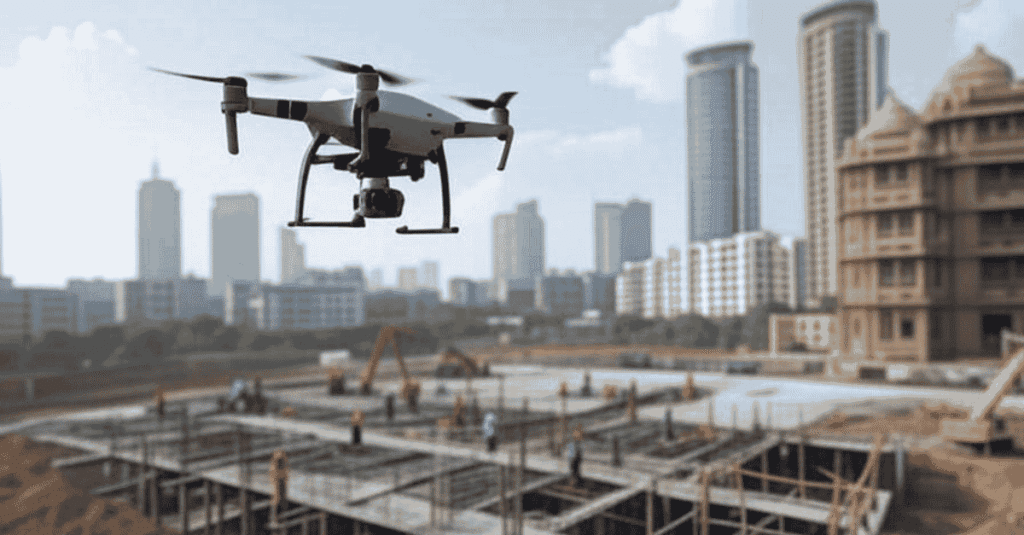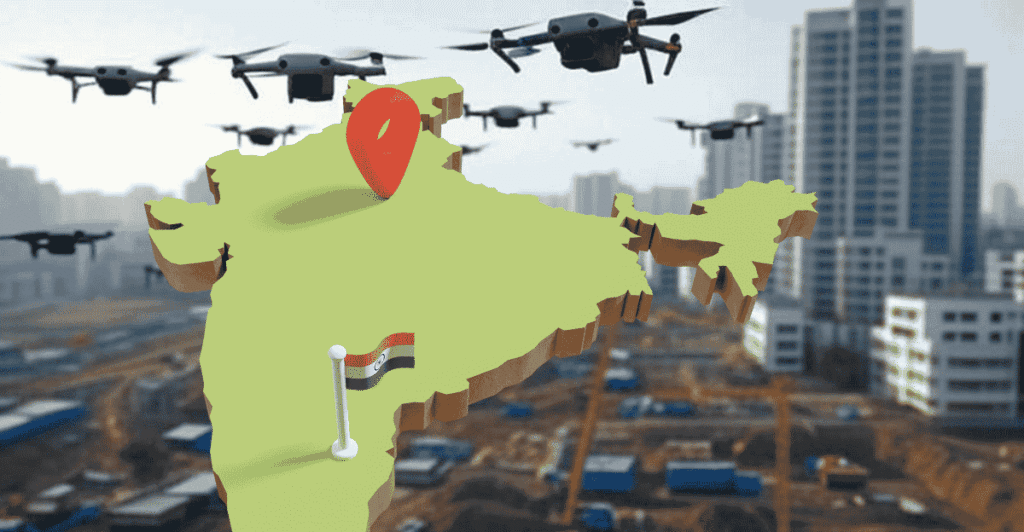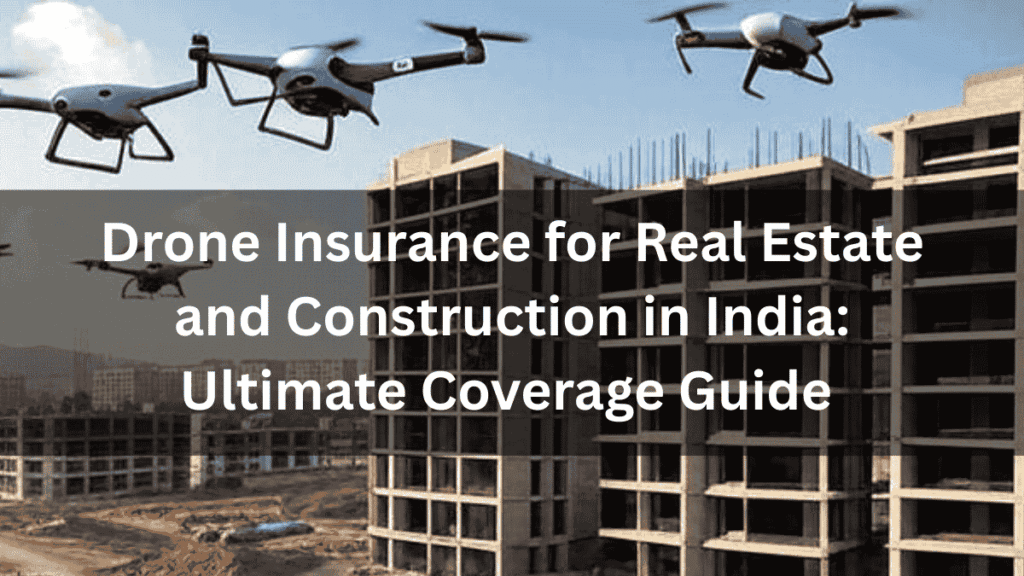In the era of rapid technological advancement, Drone Insurance for Real Estate and Construction has become indispensable for professionals navigating India’s booming property sector. As drones revolutionize site inspections and aerial mapping, securing the right drone insurance for construction in India ensures uninterrupted operations amid evolving risks.
The Transformative Role of Drones in India’s Real Estate and Construction Landscape
India’s real estate and construction industries are on a meteoric rise, contributing approximately 8% to the nation’s GDP in 2025, with projections estimating a market value exceeding $1 trillion by 2030. Drones, or unmanned aerial vehicles (UAVs), have emerged as game-changers in this dynamic ecosystem. From topographic surveys to progress monitoring, these aerial tools offer precision, efficiency, and cost savings that traditional methods simply can’t match.
Consider the sheer scale: In 2025, the Indian drone market is valued at around USD 0.47 billion, expected to triple to USD 1.39 billion by 2030, driven by sectors like construction and real estate. Globally, the construction drone market stands at USD 4.6 billion this year, forecasted to reach USD 10.3 billion by 2035—a compound annual growth rate (CAGR) of over 8%. In India, however, adoption lags slightly, with only about 30% of construction firms utilizing drones, according to recent industry surveys. This gap presents a massive opportunity for innovators and insurers alike.
Drones streamline workflows in real estate by enabling high-resolution aerial photography for property listings, virtual tours, and urban planning visualizations. In construction, they facilitate drone coverage for site mapping, capturing 3D models and volumetric data to track material stockpiles and earthwork progress. A single drone survey can reduce site mapping time from weeks to hours, slashing costs by up to 50% and minimizing human error.
Yet, this integration isn’t without hurdles. Urban congestion, variable weather, and stringent airspace rules pose operational challenges. Enter drone insurance—a safeguard that not only protects assets but also builds stakeholder confidence. As we delve deeper, we’ll uncover how real estate drone insurance in 2025 aligns with these trends, ensuring compliance and resilience.
Compliance is non-negotiable in India’s drone ecosystem, governed primarily by the Directorate General of Civil Aviation (DGCA). The Drone Rules, 2021, laid the foundation, classifying drones into categories based on weight and operations: Nano (up to 250g), Micro (250g-2kg), Small (2-25kg), Medium (25-150kg), and Large (above 150kg). For commercial use in construction and real estate, operators must secure a Unique Identification Number (UIN), Remote Pilot Certificate (RPC), and adhere to no-fly zones near airports, military installations, and crowded areas.
Fast-forward to 2025: The DGCA has introduced pivotal updates via the Draft Civil Drones Bill 2025, emphasizing stricter enforcement. Key changes include mandatory registration for all drones over 250g, enhanced beyond-visual-line-of-sight (BVLOS) permissions for large-scale site mapping, and penalties up to three years’ imprisonment for violations like unauthorized flights. The bill also mandates construction drone regulations in India to incorporate real-time tracking via the DigitalSky platform, with fines starting at ₹50,000 for non-compliance.
For real estate and construction pros, these rules mean integrating geofencing technology and certified pilots. Non-commercial nano drones remain exempt from RPC, but commercial ops—think aerial surveys over high-rise developments—require full certification. Training at DGCA-approved institutes, now numbering over 50 nationwide, takes about 5-7 days and costs ₹10,000-₹20,000.
Insurance ties directly into these regs. While not legally mandatory for recreational use, commercial operators face implicit requirements under third-party liability clauses. The 2025 amendments stipulate minimum coverage: ₹7.5 lakh for property damage and unlimited for bodily injury or death. Ignoring this could lead to operational shutdowns or legal battles, especially in liability-heavy sectors like construction.
| Key DGCA Drone Categories (2025) | Weight Range | RPC Required? | Typical Use in Construction/Real Estate |
|---|---|---|---|
| Nano | Up to 250g | No (non-commercial) | Basic aerial photography for small sites |
| Micro | 250g-2kg | Yes (commercial) | Site inspections, low-altitude mapping |
| Small | 2-25kg | Yes | Volumetric surveys, progress monitoring |
| Medium/Large | 25kg+ | Yes | Large-scale earthwork, BVLOS operations |
This table highlights how regulations scale with drone size, directly impacting insurance needs. Staying ahead means regular audits via DigitalSky and partnering with certified service providers.
Why Drone Insurance for Real Estate and Construction is a Must-Have

The allure of drones is undeniable—faster data collection, safer inspections, and data-driven decisions. But with great power comes great risk. A single malfunction could ground operations, incur fines, or worse, cause harm. In 2025, with drone adoption surging 20% year-over-year in India’s construction sector, drone insurance for construction in India isn’t a luxury; it’s a strategic imperative.
Risks abound: Collisions with structures during windy conditions, battery failures leading to crashes, or cyber vulnerabilities exposing sensitive site data. Real estate agents risk privacy breaches from unauthorized footage, while construction firms face third-party claims from drone-induced delays. Statistics underscore the urgency: Globally, drone incidents rose 15% in 2024, with property damage averaging $10,000 per event. In India, urban density amplifies these odds—imagine a drone clipping a Mumbai high-rise scaffold.
Insurance mitigates these by covering hull (drone damage), liability (third-party harm), and add-ons like payload protection for LiDAR sensors used in drone coverage for site mapping. It also shields against regulatory fines, a boon under the new 2025 bill. Financially, premiums pale against potential losses: A mid-range construction drone costs ₹2-5 lakh to replace, plus downtime costs of ₹50,000 daily on large projects.
Beyond finances, insurance fosters trust. Clients in premium real estate segments demand insured operations, viewing it as a mark of professionalism. For construction, it enables smoother subcontractor integrations and bid competitiveness. In essence, it’s the safety net propelling India’s drone economy forward.
Essential Types of Coverage: Tailoring Drone Insurance for Site Mapping and Beyond
Drone insurance isn’t one-size-fits-all. For real estate and construction, policies must address sector-specific perils like high-altitude flights over uneven terrain or data loss from signal interference. Core coverages include:
- Hull Insurance: Protects the drone’s physical structure, cameras, and batteries against crashes, theft, or wear. Essential for construction drones enduring dust and vibrations.
- Third-Party Liability: Covers damages to people or property on the ground—critical for urban real estate shoots where crowds lurk.
- Payload Coverage: Safeguards specialized gear like thermal cameras for site inspections or multispectral sensors for mapping.
- Personal Accident: For pilots, covering injuries from propeller strikes or falls during launches.
- Cyber Liability: A 2025 must-have, protecting against data hacks during aerial surveys.
For drone coverage for site mapping, opt for policies with geospatial data endorsements, ensuring lost flight logs or corrupted 3D models are recoverable. Advanced options include BVLOS riders for extended-range operations over sprawling construction sites.
| Coverage Type | Key Benefits | Ideal for Real Estate/Construction Use Cases |
|---|---|---|
| Hull | Crash/theft repair/replacement up to drone value | Routine site flyovers in harsh weather |
| Liability | Up to ₹7.5 lakh property, unlimited bodily injury | Urban property tours near public areas |
| Payload | Gear-specific protection (e.g., ₹1-2 lakh sensors) | LiDAR/RTK mapping for volumetric analysis |
| Cyber | Data breach defense, legal fees | Secure transmission of confidential site plans |
This breakdown helps operators customize policies, balancing cost with comprehensive protection.
Deep Dive into Drone Insurance for Construction in India

Construction sites are drone heaven—and hell. Towering cranes, moving machinery, and remote terrains demand robust drone insurance for construction in India. In 2025, with mega-projects like the Delhi-Mumbai Industrial Corridor relying on UAVs for 40% faster progress tracking, tailored policies are booming.
Standard construction policies extend beyond basics, including non-owned drone coverage for rented units and business interruption clauses for project delays. Premiums factor in flight hours (e.g., 200+ annually hikes rates 20%) and risk zones—coastal sites face higher wind premiums.
Choosing coverage? Assess drone specs: A DJI Matrice 300 RTK for heavy-duty mapping needs ₹20,000-₹30,000 annual hull, versus ₹8,000 for lighter models. Insurers like Tata AIG offer modular plans, bundling with equipment breakdown for vibration-prone ops.
Real-world application: On a Hyderabad township build, drones cut surveying costs by 60%, but insurance prevented a ₹3 lakh setback from a mid-air collision. As construction drone regulations in India tighten, insured fleets gain a compliance edge, avoiding DGCA suspensions.
Real Estate Drone Insurance in 2025: Trends and Tailored Solutions
Real estate drone insurance in 2025 evolves with the market’s digital pivot. Virtual staging via drones boosts sales by 20%, but aerial mishaps—like signal loss over gated communities—can derail deals. Policies now emphasize privacy riders, covering GDPR-like claims under India’s DPDP Act 2023.
Emerging trends: AI-integrated policies using flight data for dynamic premiums, dropping 10-15% for low-risk pilots. Eco-add-ons reward green real estate projects using drones for sustainable site assessments. Costs? Entry-level for hobbyist realtors: ₹4,000-₹10,000; pros with fleets: ₹30,000+.
Integration with proptech platforms allows seamless quoting via apps, aligning with 2025’s contactless ethos. For luxury segments, unlimited liability extensions protect against high-value property claims.
Top Drone Insurance Providers in India: A 2025 Comparison
India’s insurance landscape features a mix of giants and specialists. Here’s a curated list based on coverage depth, claims efficiency, and sector focus:
- Tata AIG: Pioneer in drone policies, offering hull up to ₹10 lakh and BVLOS endorsements. Claims settled in 7-10 days.
- ICICI Lombard: Affordable for startups, with real estate bundles including cyber coverage. 95% customer satisfaction in 2025 surveys.
- HDFC ERGO: Construction-focused, with fleet discounts up to 25%. Strong in payload for mapping tech.
- Bajaj Allianz: Via TropoGo platform, pay-per-flight options for occasional users. Quick online issuance.
- New India Assurance: Government-backed reliability, ideal for large infra projects. Unlimited liability standard.
| Provider | Starting Premium (₹/Year) | Key Strength | Best For |
|---|---|---|---|
| Tata AIG | 8,000 | Comprehensive add-ons | High-volume construction |
| ICICI Lombard | 5,000 | Cyber/privacy focus | Real estate agents |
| HDFC ERGO | 10,000 | Fleet management | Mid-sized builders |
| Bajaj Allianz | 6,000 | Flexible plans | Freelance surveyors |
| New India | 12,000 | Regulatory compliance | Mega-projects |
This table aids quick decisions, factoring 2025 market data.
Cost Breakdown: What to Expect for Drone Insurance Premiums
Premiums hinge on drone value, usage, and location. For a ₹3 lakh construction drone with 150 flight hours:
- Basic (Hull + Liability): ₹7,500-₹12,000
- Advanced (Payload + Cyber): ₹18,000-₹35,000
Factors inflating costs: High-risk zones (e.g., +15% in metros), pilot experience (-10% for certified), and deductibles (₹5,000-₹20,000 lowers premiums 20%).
| Drone Value (₹) | Basic Coverage Cost | Advanced Coverage Cost | Influencing Factors |
|---|---|---|---|
| 1-2 Lakh | 4,000-8,000 | 10,000-20,000 | Low-altitude ops, experienced pilot |
| 2-5 Lakh | 5,000-15,000 | 25,000-40,000 | Site mapping, urban flights |
| 5 Lakh+ | 15,000-30,000 | 40,000-60,000 | BVLOS, heavy payload |
Budgeting tip: Multi-year policies save 15%, and telematics discounts reward safe flying.
Streamlining Claims: A Step-by-Step Guide
Filing a claim shouldn’t add to the chaos. Here’s the 2025 process:
- Immediate Reporting: Notify insurer within 24 hours via app/hotline, submit flight logs.
- Documentation: Photos, videos, DGCA incident report, witness statements.
- Assessment: Surveyor visit (2-3 days), virtual for minor claims.
- Settlement: 7-14 days for hull; liability varies by investigation.
Pro tip: Use geofenced apps to auto-generate reports, cutting processing time by 40%.
Real-Life Case Studies: Lessons from Drone Incidents
Case Study 1:
In a 2024 Bengaluru real estate shoot, a drone collided with a billboard, causing ₹2 lakh property damage. Insured via ICICI Lombard, the claim covered full liability, resuming ops in 48 hours—highlighting third-party essentials.
Case Study 2:
A Gujarat construction site saw a battery failure mid-survey, totaling a ₹4 lakh drone. HDFC ERGO’s hull policy reimbursed 95%, with business interruption adding ₹1.5 lakh for delays. This underscores payload coverage for rugged environments.
Case Study 3:
Cyber breach in a Mumbai mapping project exposed site blueprints. Bajaj Allianz’s rider covered ₹5 lakh in legal fees, averting a ₹20 lakh lawsuit under data laws.
These anonymized examples, drawn from 2025 industry reports, illustrate insurance’s ROI—preventing escalations in 85% of incidents.
FAQs On Drone Insurance for Real Estate and Construction in India
Q1: What is drone insurance for real estate and construction in India?
Ans: Drone insurance for real estate and construction in India is a specialized policy covering drones used for tasks like site mapping, aerial photography, and progress monitoring. It protects against drone damage, third-party liabilities, payload losses, and regulatory fines, ensuring compliance with DGCA rules in 2025.
Q2: Why is drone insurance essential for construction in India in 2025?
Ans: Drone insurance for construction in India is crucial in 2025 due to rising drone adoption, strict DGCA regulations, and risks like collisions or data breaches. It covers hull damage, third-party claims, and project delays, safeguarding against losses averaging ₹2-5 lakh per incident.
Q3: What does real estate drone insurance cover in 2025?
Ans: In 2025, real estate drone insurance covers hull damage, third-party liability (up to ₹7.5 lakh for property), payload protection for cameras, and privacy breaches under the DPDP Act. It also includes cyber liability for data hacks during aerial property shoots.
Q4: How do construction drone regulations in India affect insurance in 2025?
Ans: The 2025 Draft Civil Drones Bill mandates registration, RPC for commercial drones, and real-time tracking via DigitalSky. Insurance aligns with these by requiring minimum liability coverage (₹7.5 lakh property, unlimited bodily injury), ensuring compliance and protection against fines up to ₹50,000.
Q5: What is drone coverage for site mapping in India?
Ans: Drone coverage for site mapping in India includes hull insurance for drone damage, payload protection for LiDAR/RTK sensors, and liability for third-party harm. It ensures recovery of geospatial data losses, vital for 3D modeling and volumetric analysis in construction.
Q6: How much does drone insurance for construction in India cost in 2025?
Ans: In 2025, drone insurance for construction in India costs ₹4,000-₹30,000 annually for basic hull and liability coverage, and ₹10,000-₹60,000 for advanced plans with payload and cyber add-ons, depending on drone value and flight hours.
Q7: Who are the top drone insurance providers in India for 2025?
Ans: Top providers in 2025 include Tata AIG (comprehensive add-ons), ICICI Lombard (cyber focus), HDFC ERGO (fleet discounts), Bajaj Allianz (pay-per-flight), and New India Assurance (regulatory compliance), offering tailored plans for real estate and construction.
Q8: What are the key types of drone insurance coverage for real estate?
Ans: Key coverage types for real estate drones in 2025 include hull insurance (drone damage), third-party liability (public/property harm), payload coverage (cameras/sensors), cyber liability (data breaches), and privacy riders for DPDP Act compliance.
Q9: How can I file a drone insurance claim in India in 2025?
Ans: To file a drone insurance claim in 2025, report the incident within 24 hours via the insurer’s app, submit flight logs, photos, and DGCA reports, undergo assessment (2-3 days), and expect settlement in 7-14 days for hull claims.
Q10: What are the emerging trends in drone insurance for 2025 in India?
Ans: Emerging trends in 2025 include AI-driven dynamic premiums, blockchain for secure claims, eco-discounts for sustainable drone use, and integrated UTM compliance, reducing premiums by 10% and enhancing coverage for real estate and construction.
Q11: What risks does drone insurance for real estate and construction in India cover in 2025?
Ans: In 2025, drone insurance for real estate and construction in India covers risks like drone crashes, third-party property damage, bodily injury, payload loss (e.g., LiDAR sensors), data breaches, and regulatory fines, protecting against losses averaging ₹2-5 lakh per incident.
Q12: How does drone coverage for site mapping benefit construction projects in India?
Ans: Drone coverage for site mapping in India benefits construction projects by insuring against drone damage, sensor loss, and data corruption, ensuring uninterrupted 3D modeling and volumetric analysis, which cuts surveying time by up to 60% in 2025.
Q13: Are there any discounts available for drone insurance in India in 2025?
Ans: Yes, in 2025, drone insurance discounts in India include 15% savings on multi-year policies, 10-15% reductions for low-risk pilots using telematics, and eco-discounts for sustainable drone operations in real estate and construction projects.
Conclusion
As India’s real estate and construction sectors soar, Drone Insurance for Real Estate and Construction stands as the cornerstone of safe, compliant innovation. From mastering construction drone regulations in India to selecting drone coverage for site mapping, this guide equips you for 2025’s challenges. Don’t let a single flyby jeopardize your projects—consult providers, customize coverage, and elevate your operations. The future is airborne; ensure it’s insured.

